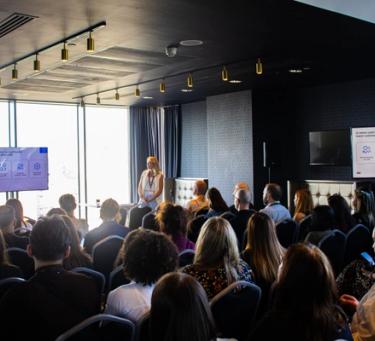Event6 min read
IDHL presents: Unboxed - Adapting to 2025's Challenges & Opportunities
Mon Apr 14 2025 | Antonia Isernia

- Event
Tags
Digital marketing is evolving rapidly, and businesses need to stay ahead of the curve to compete and grow. Unboxed was an opportunity to explore the future of marketing head-on, tapping into the exciting shifts shaping the industry in 2025.
We tackled some of the most pressing topics in digital marketing today, offering attendees valuable insights to navigate the competitive road ahead. From AI’s boom and cookie-less technology, to the power of data and user journeys, no stone was left unturned as we revealed the challenges and opportunities that 2025 holds.
Did you miss Unboxed? No problem. Below, we’ve rounded up the key takeaways from the day.
The digital landscape in 2025
IDHL’s Head of Strategy, Sarah Dillon, kicked things off by discussing the evolving digital landscape marketers are working within this year. She focused on three areas that are driving change in paid media: AI, third-party cookies, and audience reach.
AI is reshaping how brands engage with customers, offering the potential to lower customer acquisition costs and provide deeper customer insights. However, over-reliance on AI can lead to generic content that lacks a unique brand voice, which is crucial to maintaining a strong identity.
Despite Google’s delay in phasing out third-party cookies, marketers must still focus on consumer privacy. Many businesses are moving away from mobile ID and location data in favour of more privacy-forward solutions. The end result? Better impact, lower costs, and broadened reach, without losing valuable audience connections.
While average time online isn’t changing significantly, platform usage is. Brands need to focus on where their target market spends their time online - whether it's on TripAdvisor, TikTok, or traditional search engines. Omnichannel strategies are the future. They're key to harnessing data collection and personalising experiences that drive retention, loyalty, and performance.
The power of performance marketing
Reaching the right audience with the right message at the right time has always been a delicate balancing act. Kevin Liang from our partner, StackAdapt, shared a three-pillar formula for solving this challenge: Orchestration, Analytics, and Personalisation.
He explained how these elements must work together to solve the problem. Orchestration is about smart audience segmentation and predictive profiling, which allows brands to craft tailored content based on user engagement. Combined with a comprehensive analytics toolkit that considers incrementality and cross-channel attribution, brands can deliver dynamic, personalised content at the perfect moment.
Kevin showcased the power of this approach with a case study that illustrated how implementing this framework led to a 15% sales lift for an eCommerce client and a 6% increase in topline revenue by refining digital channel strategies.
Tracking results for growth
Michael Cheung, Senior Enterprise Customer Success Manager at our partner Yotpo, offered an in-depth look into how data can drive peak performance. He highlighted the importance of leveraging customer reviews alongside visual user-generated content (UGC). This combination increases engagement, builds customer confidence, improves product development, and ultimately reduces returns.
Yotpo’s proprietary technology helps brands analyse data from customer feedback to uncover insights, spot trends, and provide benchmarks against industry averages. Real-world customer experience data is a powerful tool for turning intent into trust, which ultimately leads to higher engagement and more sales.
In a featured case study, Yotpo’s UGC-focused strategy, powered by AI, Machine Learning, and Natural Language Processing, generated a 44% increase in buyer intent and up to a 200% boost in conversion rates.
Understanding user journeys and touchpoints
Attribution modelling is essential to unlocking the full potential of user journeys and touchpoints. But there’s no one-size-fits-all approach - what matters is understanding which touchpoints drive conversions. Was it a Facebook ad? A search result?
IDHL’s Harry Lote explained that Google Analytics 4 (GA4) offers a more modern approach to tracking user intent throughout the funnel, going beyond just the first and last touch. This approach provides more accurate reporting, making attribution clearer for both internal teams and stakeholders.
With users spreading their time across multiple platforms, attribution modelling helps identify which touchpoints deliver the most conversions. However, Harry stressed that businesses need a tailored attribution model based on variables like user intent, channel, timing, and location.
Using data to drive action
Data is only valuable if it leads to meaningful action. This takeaway was shared by Media Strategy Director, Tom Walkden, as he wrapped up the session.
Site engagement data can be leveraged within ad platforms to enhance prospecting and acquisition, while GA4 data is invaluable for lead generation. Contextual targeting increases relevance and engagement, while audience targeting data helps to boost click-through rates.
In today’s data-rich environment, it’s essential to focus on the metrics that matter most to your business. Tom concluded with a powerful strategy: decide which data matters before you judge performance.
Unboxing the future together
If you have any questions about our Unboxed event and the insights shared, get in touch. In the meantime, follow us on social media to stay updated on future events and our industry-leading content.








